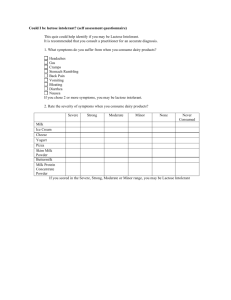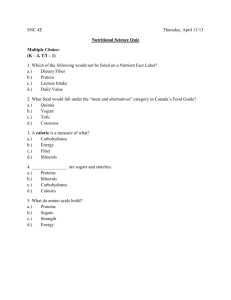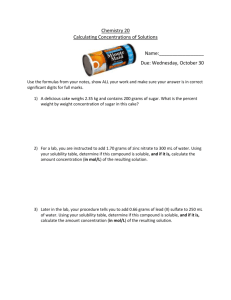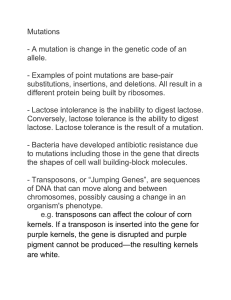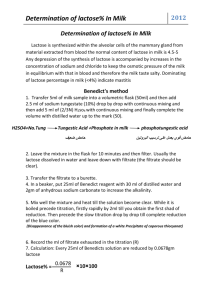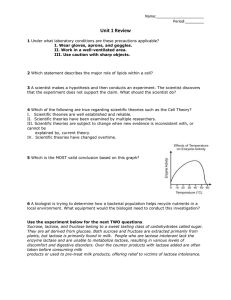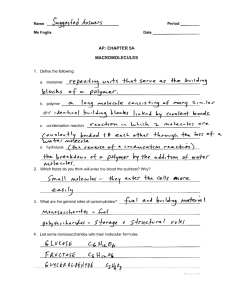Properties of lactose as determinants of crystallization behaviour and of industrial applications
advertisement
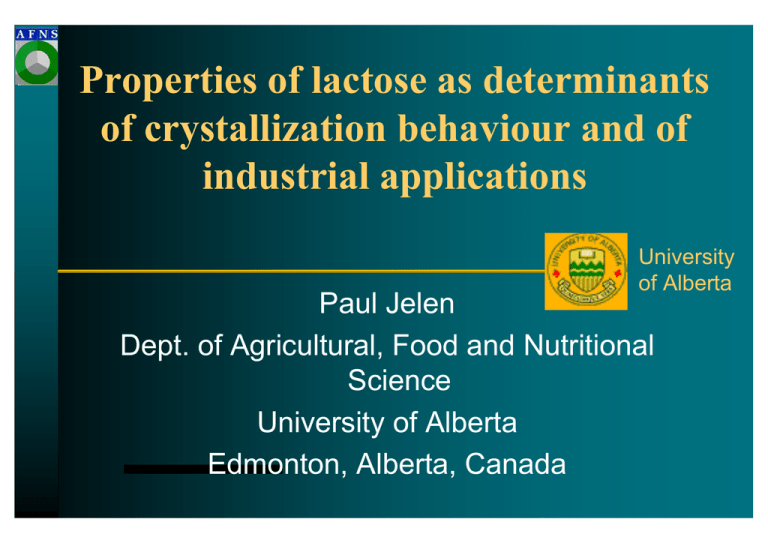
Properties of lactose as determinants of crystallization behaviour and of industrial applications University of Alberta Paul Jelen Dept. of Agricultural, Food and Nutritional Science University of Alberta Edmonton, Alberta, Canada Lactose Milk of (almost) all mammals Primary source of energy for the neonate Highest concentration (7%) in human milk Principal component of cow’s milk (4.5 - 5%; 53% of non-fat solids) Cheapest reducing CHO on the market Concentration of lactose in milk of different mammals Species Species Lactose Lactose content content (%) (%) H H22O O content content (%) (%) Human 7.1 87.1 Cow 4.6 87.3 Buffalo 4.8 82.8 Goat 4.3 86.7 Sheep 4.8 82.0 Schematic representation of the lactose disaccharide molecule Important basic properties of lactose Disaccharide (glu-gal) Two stereoisomers (α- and β) > mutarotation Reducing sugar >>> browning reaction Low sweetness (20% of sucrose at 5% conc.) Low solubility (18% w/w at 20°C) > low osmotic pressure > slow crystallization Forms of lactose α - lactose, β – lactose In solution the ratio of α : β is about 1 : 2 Effect of temperature and mutarotation on > solubility > sweetness > crystallization behaviour In crystalline state > α – lactose contains one H2O molecule > α – lactose anhydride (heating above 130oC) > β – lactose (above 95oC) contains no H2O Properties of lactose affecting the dairy industry > Fermentable by lactic acid bacteria > Crystallizes in highly concentrated dairy foods (sweetened condensed milk, ice cream, whey cheese mysost) > Low sweetness – unsuitable as a sweetening agent, can be improved by hydrolysis > Lactose malabsorption limits consumption of dairy foods by lactose intolerant consumers > Fermentable by aquatic bacteria - high BOD of whey > Unique crystallization behaviour Focus of this presentation Crystallization phenomena Model systems – experimental methods Solubility Real life dairy foods Sweetness phenomena sensory impact in dairy foods use for protein standardization Lactose hydrolysis Lactose derivatives and pharma-lactose Centuries of dairy science: lactose 1633 – Bartoletto isolated and described lactose as “essential salt without nitrogen” 1688 - Ettmueller isolated lactose from whey and purified by recrystallization 1814 – 1820 analytical work by Berzelius 1902 – 1942 fundamental work by Hudson 1936 – 2007 lifetime achievements of Prof. Andrei Georgievich KHRAMTSOV Lactose crystallization Supersaturated solution Concentrated dairy systems (condensed milk, ice-cream, whey cheese) Whey or whey permeate >> evaporation and cooling for production of lactose commodity Crystalline habit and crystal growth mechanism (α-lactose) Single crystal method to study the crystallization phenomena Method described by Professor J.A. Kucharenko from Polytechnical Institute, Kiev, for study of sucrose crystallization Series of 12 articles published in “The Planter and Sugar Manufacturer” (New Orleans), from May 12 to July 28, 1928 (volumes 80 and 81) Crystallization velocity, density, effects of impurities, solubility, supersaturation Single crystal method adapted to study lactose crystallization Lactose crystal growth: single crystal experiments Van Kreveld (1966 – 1969): crystals grow from the apex of a pyramid down Jelen (1971 – 74): effect of supersaturation and growth promotion by mineral impurities Visser (1980 – 1983): crystal growth retarders, structure of lactose crystal Jelen (1996) – crystallization velocity with assumption of bottom plane growth Lactose solubility Temperature oC Concentration of saturated solution (g / 100 g H2O) ___________________________________________ 30 oC 50 oC 70 oC 80 oC 24.0 44.0 77.8 98.9 Effect of minerals on lactose solubility at 30oC Salt added (5 g / 100 g H2O) Estimated solubility (g / 100 g H2O) __________________________________________________ Control (no salt) Calcium chloride Magnesium sulphate Lithium chloride Potassium phosphate 24.4 24.3 23.0 21.9 26.5 Lactose crystallization velocity Average growth rates of lactose crystals in model lactose solutions with or without the addition of salts. Lactose crystals under microscope Scanning electron microscopy of spray dried demineralized permeate powder (courtesy Dr. Kalab, Ottawa). Light microscopy of demineralized whey permeate powder (courtesy Dr. Kalab, Ottawa). Growth rates of lactose crystals o (30 C, supersaturation 9 g) Exposed face All Sides Top (truncated) Bottom Crystallization rate (mg m-2 min-1) 160.9 ± 12.1 2.5 ± 3.0 -0.6 ± 3.4 211.8 ± 69.3 Growth rates of lactose crystals (30oC, supersaturation 10g) Assumptions Growth on all sides Approximate Crystallization rate (mg m-2 min-1) 80 (Jelen 1972) 350 (Bhargava/Jelen, 1996) Growth on bottom side only ______________________________________ 320 (Smythe, 1971) Sucrose Promoters and inhibitors of crystal development Promoters Inhibitors Lithium chloride β-lactose Calcium chloride Riboflavin (at low concentrations) Galactose Some phosphates Gelatin Other electrolytes (?) Potassium salts Lactose solubility and crystallization in whey, UF permeate or dairy foods Nucleation vs crystal growth Components affecting solubility and crystal growth Very high supersaturation – nucleation favored Ice cream, frozen desserts, Sw. Cond. Milk Norwegian whey cheese Mysost Lactose crystals in whey cheese Mysost Lactose crystals in whey cheese Mysost Lactose crystals in whey cheese Mysost Lactose crystals in whey cheese Mysost Effect of mineral impurities on lactose crystals Sweetness of lactose Much lower than sucrose (20 % at 5% conc.) Effect of temperature and concentration Addition of less that 1% lactose to milk clearly noticeable (Jelen & Michel, 1999) Lactose used for down standardization of protein in dry milk Sweetness can be increased by hydrolysis Lactose hydrolysis Reasons Reasons Methods Low solubility (sandiness) Acid + heat Low sweetness Free enzyme Lactose intolerance Immobilized enzyme Oligosaccharides Disrupted bacteria 50 Mpersons market in USA alone Characteristics of lactose hydrolysis methods • Acid-catalysed hydrolysis – technological and material problems • Immobilised enzyme technology – rarely succesful (Valio) • Membrane - based enzyme reactors – theoretically interesting, rarely used • Free (soluble) purified enzymes – used in industrial practice – Tetra-lacta process – home use in milk or as a dietary aid (pill) How widespread is lactose intolerance in the world? Lactose hydrolysis by disrupted lactic acid bacteria • framework: Canadian research network on lactic acid bacteria for applications in dairy industry (University of Alberta). • objective: to investigate a “simple” approach to the lactose hydrolysis problem using lactase enzyme produced by common dairy bacteria after their disruption as crude enzyme extracts (CEE) obtained by microfluidization Components of the proposed lactose hydrolysis process well defined (GRAS) enzyme source (Lactobacillus bulgaricus 11842) well defined (GRAS) medium (skim milk, whey) culture production, separation and disruption (bead mill, high pressure homogenizer, Microfluidizer) use of the “dirty” CEE for lactose hydrolysis without additional purification Schematic representation of the proposed process culture propagation (skim milk) centrifugation or MF culture disruption milk processing (NF, HPUF, UF, DF) viable cell deactivation (MF) lactate, salts reprocessed milk addition to milk or whey UF permeate downstream processing downstream processing SEM images of Disrupted L. bulgaricus 11842 Control Sonication (6 min) 1 pass (homogenizer) Bead Mill (6 min) Lactose derivatives: GALACTO - OLIGOSACCHARIDES Properties Properties Applications Di-, tri-, tetra- or higher -saccharides Probiotic foods Intermediate sweetness Nutraceutical (FOSHU) foods (anticarcinogenic) Highly heat and acid stable Non-cariogenic foods Bifidogenic factor Competing against inulin Non-digestible Lactose derivatives as value added products Lactulose: 16 kt/year Lactitol: 10 kt/year in 1 plant Lactobionic acid: potential for 1kt/year in 1 German plant Oligosaccharides: Galactooligosaccharides: n/a Lactosucrose: 1.6 kt/year Pharmaceutical lactose products α-lactose: 100 mesh (>125 µm) Agglomerated / granulated Spray dried (80% crystals, 20% amorphous) Anhydrous lactose: α -lactose (heated >130°C) β-lactose (crystallized >93°C) Pharmaceutical lactose processes Whey or UF permeate (crystallization) Crude lactose Refining recrystallization Refined α-lactose Heating >130°C Spray drying Anhydrous α -lactose Spray dried α-lactose Crystallization on roller driers >93 °C β-lactose Industrial processors of pharma-lactose Manufacturer Product trade name Lubricant Meggle Tablettose Cellactose Cellulose BASF Ludipress PVP DMV Pharmatose Lactitol New aspects of lactose science and industrial applications Use of microcrystalline lactose as a flavour carrier Lactose effects in microencapsulation of fat by WPC Caking in bulk lactose Use of lactose for protein standardization in non-fat-dry-milk and fluid milk Traditional uses of isolated lactose Food (1996 total 425 kt) Other (1996 total 175 kt) Infant foods Confectionery Other (bakery, dry mixes) Dairy (protein standardization) Pharmaceuticals Fermentation Feeds Derivatives THANK YOU!
